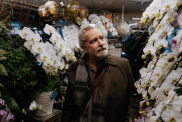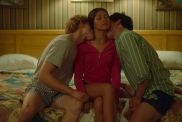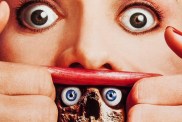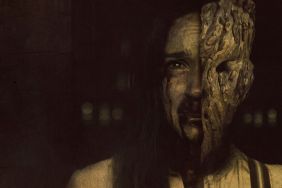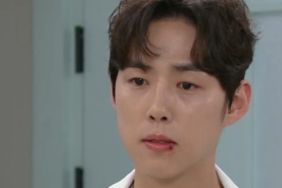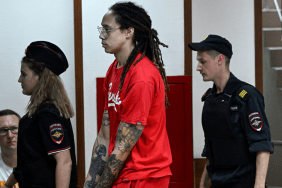
Lange, of course, needs no introduction having starred in films like Tootsie, The Postman Always Rings Twice and Big Fish. On the genre front, her big screen career began with the 1976 remake of King Kong, starring Jeff Bridges and Charles Grodin, and later carried into the Cape Fear remake with Robert De Niro.
Inside, we present the press Q&A with Lange that ShockTillYouDrop.com was thrilled to participate in.
Question: Is there ever a time when something is sent your way in the course of these shows that its just too much for you, or are you the one thats egging Ryan Murphy and company along? Do you want more challenges in your American Horror Story tenure?
Jessica Lange: Well, there are times when Ive said, I think this is too much, but thats not been too often because they tend to write for me less action and I dont know, maybe more kind of psychological. But thats been better. I wouldnt really know how to do a lot of the really intense action scenes, so I have a few of those but not many. I think there was a leap of faith on my part just thinking, well, if Im going to do this Im going to do this. And I think as an actor you have to have trust, you have to believe that somebody is taking care of you or watching your back, because with a part like this especially and where were going with it, I cant pull any punches, I cant do it halfway, especially when youre dealing with madness and this descent into madness, and I really felt like, okay, Im going to embrace this 100% and hopefully somebody will look out for me and not let me completely humiliate myself. Yes, its combined.
And sometimes I ask them specifically for stuff, like I want to sing or I want to dance or I want to do this, something frivolous, and sure enough it shows up in the next script, or I want to play a lounge singer from the 40s, so somehow its a give and take situation and then I end up doing things like scenes where I say, okay, Ive done two, I will not do any more. This is enough. I dont enjoy this. This is not my character. So thats how we work really. Ive never worked this way before where its so fluid between the creators, the writers, and me. Usually you get a script and its there and its start to finish, and this kind of evolves and morphs as we go along. I do have more input, but then there are of course limitations within the structure of the whole story and the trajectory of where its going. But its been interesting. Its been an interesting challenge.
Question: I was just interested really in the difference between your character from Season 1, Constance very much seemed to be the puppet master, but in Season 2 Jude is fast becoming our very complex hero as the season develops. How different are Judes intentions to Constances, and what did you really want to bring to Jude that you may not have been able to do with Constance?
Lange: I think puppet master is a very good description of Constance. The thing that I found, kind of the spine of the character of Constance, was that this was a woman who had basically lost everything and had nothing left to lose and also was extremely, what can I say, unafraid, so she just manipulated her way and put herself in situations that probably other people would not have. With Jude she has a lot to lose because shes holding on to something that she feels has saved her life and redeemed her, and then when it all becomes clear that everything was false, from the idea that she did not run over and kill this child, which is what sent her on this whole path, trying to find some kind of life, some redemption, some spiritual life, that when she discovers everything is false from the beginning, theres a descent into madness that is completely different and for me much more interesting to play.
I thought Constance was a wonderful character, she was kind of a throwback to the 40s, kind of tough dame, sweet talking but with a real edge, she did not suffer fools, nothing went past her, she had a way of moving through everything and getting what she wanted. This woman is much more vulnerable and I think in some way tragic. Shes destroyed her life. Shes an addict. Shes an alcoholic. Shes had bad luck with men, a lot of bad men in her life. And shes come to the end of the road with the hopes that this church, that this man, the Monsignor, is going to save her, that shell become something else, that shell make her life worth living. And of course that all comes down, crashing, and shes left absolutely alone, completely and totally alone, and those are two things I love playing because you also find them in Williams characters, the thing of aloneness, the idea of being completely alone in the world and couple that with madness, and its a really potent combination to play.
I know Im rattling on. Its hard to talk about these characters succinctly, but that would probably be the difference. I dont know if that answered your question.

Lange: Really, no, because this thing kind of has a life of its own. Its like a river, it moves one direction and then it continues that way and then it shifts direction. I think Ryan has these things roughly plotted out of where things are going to go, but I dont always know ahead of time. I have to say I kind of understood that we would be dealing with this kind of descent into hell, but I did not know really that Jude would rise to the top of this in a way, so no.
And in a way thats what makes it interesting to play, because usually you get a script and you have all the story, all the acts are there for a play, you know what happens in the first, second, and third act, and you know how it starts, you know where you go and where it finishes, and with this its a whole new experience. I dont know where its going. Its kind of like life, you dont know whats going to happen next. And its been an interesting way to work. Its made me work in a much more fluid, I think in a braver way in a way, of just taking every chance that comes along. I dont plan things ahead of time. I dont map out the character. I dont do anything. Its been for me a great, powerful exercise in working just in the moment, from this moment to the next moment. And I actually think that its made me a better actor, in a way, because of not being able to go into something pre-determined.
Question: I just wanted to ask specifically about [this] weeks episode. In the previews we see that Sister Jude is tied down in a bed and is now a patient at Briarcliff, and this also kind of sets up the opportunity for her to create an alliance with Lana and Kit. What can you tell us about next weeks episode?
Lange: I dont know what Im allowed to say about whats coming up or not. Im always a little timid about talking about the plot line. Yes, everything gets put in motion now as far as Briarcliff and the demise of that institution and everybodys departure from it, except mine. Yes, she actually does now try to right the wrongs that she has done, but of course shes totally trapped within her own making, in a way. Yes, I dont know, beyond that Im not sure I should say where its going.
Question: This show has such stunning visuals, it differentiates itself from other TV series in that its very visually, almost photographic to me in the snapshots and the music, and the way that they fade in and out. You mentioned earlier the collaborative nature of you with Mr. Murphy, and I was wondering if you would ever collaborate with the DP or ask questions or have an opinion about the visual layout of the show, since youre such an accomplished photographer?
Lange: Well, Im very curious about the way it looks, yes. I always watch cinematographers on the set because in some way I think having spent 30 years making movies, maybe its 35 now, I think Ive been informed in my photography by filmmakers, by the cinematographer, so that Im drawn always, when I take a photograph what prompts me to lift my camera and click the shutter usually has a great deal to do with setting, with lighting, with the choreography, the grouping.
So I think that, in fact Im just looking now at the wall, Ive got all these little 8x10s of Day of the Dead, I was there in Oaxaca just a month ago, and yes, it has a very cinematic feel to it. And I think because Ive been doing movies as long as I have, that one lends itself to the other. I understand, and Im very curious, about how you light specifically for dramatic emphasis. And I think Michael Goy in this series that were doing is a master at that. He really does an amazing job lighting this show. Yes, its amazing to watch him do it and to create the emotions. And through the ambience, through the lighting, right away you have an instantaneous emotional reaction before the scene even plays out.
Question: I just was wondering if you could talk about the fact that youve really become a fan favorite and this show seems to have, throughout two seasons, opened up a whole new audience for you, a whole new energy to what youre doing. Whats the reaction been like, and what do you make of it?
Lange: Well, I dont follow that side of it too much. I understand that theres a demographic that otherwise probably wouldnt know my work. Im always surprised when young people dont know certain actors or are not familiar with certain films, even people who are working in Hollywood, which is really alarming, are not aware of certain filmmakers if its more than 20 years ago or 25 years ago, or maybe even 15 years ago.
So I understand that this has given me a whole new exposure that probably I wouldnt have had otherwise, because the kind of films that I do, I dont do big studio films that gross $100 million or whatever, Ive mostly done small, independent movies, and that has a very limited audience. So this is a greater audience probably than Ive had for a long, long time, and its also the demographic is much younger, so thats all good, I guess. I dont know ultimately what that means, but yes, Im glad people are looking at the work. Im very grateful for that.

Lange: I dont think of any of my characters as creepy. They might be misguided and they might be crazy, but definitely not creepy. Like I said earlier in this interview today, theres nothing that appeals to me more than playing madness, and that I do know how to dip into. But thats quite different than creepy. Im sorry, I didnt find anything creepy about these characters.
Question: I think in the first season the scares were certainly slightly more supernatural and this one its more real, serial killers, and far more bloody. What effect do you think that has on the audience for American Horror Story? How are the scares different this time around?
Lange: I think its darker. I think the whole story is darker this time. It deals, I think, on a much darker psychological level. Youve got human experiments. I think in some way last season was a ghost story, and this season it really is the darker parts of the human psyche that Ryan is exploring. I think the affect is that its hard to watch, I hear that from people a lot. I cant watch it, its too horrifying, or whatever. I dont know, I think you have to strike a balance. I think this season became darker than anybody anticipated, just because of the subject areas that they laid out in the beginning, I mean, the thing with the ex-Nazi SS doctor and human experiments, and the serial killer based on this character Ed Gein. Yes, the warehousing of human beings in these institutions, madness, I mean, yes, theres a lot of subjects that theyre covering, the Catholic Church, that lend themselves to great horror stories.
Question: I was wondering if you could talk about the process you go through as an actress. You switched from such memorable characters as Big Edie to Constance to Sister Jude, whats the process you go through?
Lange: It depends. I work differently on all of them, but recently, like I said earlier, Ive been trying to work in a very immediate fashion so that Im relying much more now on just pure imagination that comes up in a moment and I just follow that through rather than trying to plan anything or design anything. And I think thats the biggest difference.
With fictional characters it really is you rise and fall on the strength of your imagination, I think. With somebody like Big Edie, of course, I had a wealth of resource material to draw from. But the thing that Ive been working on more and more lately is finding the character through the voice, and sometimes I would work on finding it through the emotional core, which is still the main element I work in, but the external instead of finding it through movement or body or whatever, now I try to find it through voice. And its been very interesting, because with Big Edie every day Id come to the set I would listen to her voice, I would put on the DVD of Grey Gardens and not look at the image but just hear the voice, and as soon as I found that voice I could drop into the character.
Now, with Sister Jude this year Ive also found a voice that as soon as its there and present I feel like I think into the character. And Ive done something with the voice as its gone along that its been changing as we go down this rabbit hole. So thats the process, I dont know if that makes any sense to you, but thats kind of how I find that Im working now, I mean, strictly through the imagination and then looking for the character, trying to find the character mostly through the voice.
Question: One of the things that Ryan does for you on this show is surround you with really great actors…Sarah Paulson, Ian McShane, and James Cromwell, and Im just wondering if you can talk a little bit about that, about getting to work with so many actors throughout the course of this series, and if you can talk specifically about a scene where maybe it felt really great to be working with somebody.
Lange: Yes, I think the acting has been really amazing this year. A lot of the actors came back from last year, and its wonderful, I think what Ryan had in mind is this kind of Mercury Theatre, this idea of having a repertory company and moving them from one project to another, and theres something kind of great about that, watching these actors come in and create a different character.

Question: I wanted you to maybe go further about that scene with Frances, because it seemed like that, to me, was the pivotal scene for Sister Jude because she finally bares her soul and she really feels like shes come to, I guess, at odds with what shes had in her life. So could you maybe talk about prepping for that scene and maybe building up to that scene through the season and then finally being able to work on it?
Lange: Well, first I thought it was really well written, so thats the first thing. If youve got it on the page, then you can find a way. The worst thing in the world is to try to play a poorly written scene, so that right away I give credit to the writers and to Ryan. But whats been kind of interesting about this process is that it keeps unfolding and unfolding and you come back each episode with the experience of what youve already played, and I just felt that that scene is the turning point for my character, because after this she becomes entrapped, and its such an honest and vulnerable moment that it shifts the playing field, in a way, from who she was up until that point and who shes going to become.
But, I dont know, every once in a while, and I dont really know how to describe it, something just happens within a scene and it feels right. It feels honest. It feels pure. And it feels like its elevated the character to something else. So, yes, its a mystery to me why some things work and other things dont. But, yes, I really felt that that scene was kind of the crux of the character.
Stay up to date with the latest horror news by “liking” Shock Till You Drop’s Facebook page and following us on Twitter!
